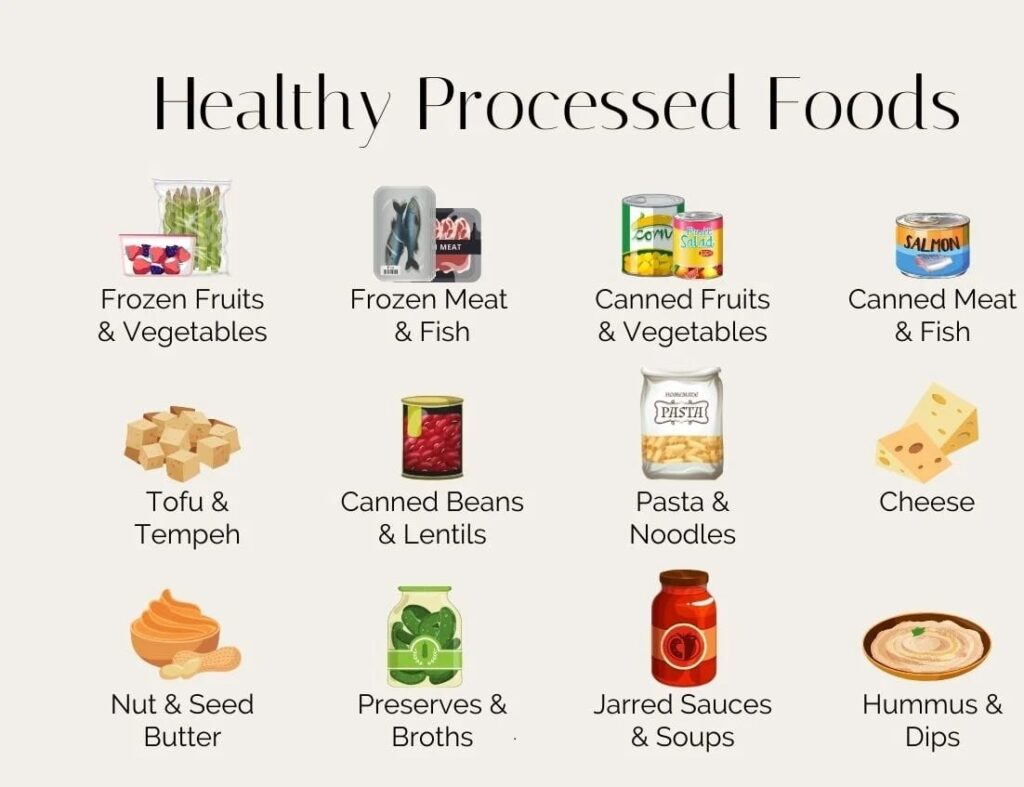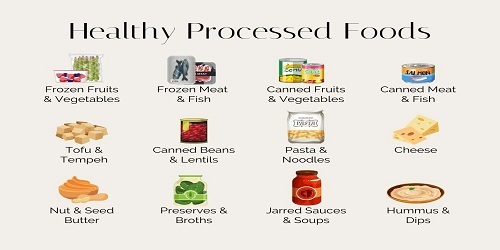When we hear about processed or ultra-processed foods, alarm bells go off. However, processed foods don’t have to be bad just because. We show you different processed foods that can be healthy.
When the word “processed” comes up in food, alarm bells usually go off. But, be careful, because a defendant does not have to be bad, per se. On the contrary, there are “good processed ones”, or simply processed ones. In other words, the fact that a food has to be processed, which is nothing other than manipulating it in some way, does not mean that it automatically has negative effects. Processing is essential in the preparation of food and it is its nature, and especially the addition of other foods or substances, that determines whether a process is bad or not. But let’s look at it in depth.
What is the difference between processed and healthy processed foods?

Before continuing, it is necessary to point out an essential clarification: What is processed food? Well, it is nothing other than one that has been subjected to some type of treatment or processing to change its natural state. An egg turned into an omelet? Processed. A homemade hamburger? Processed. A fish fillet? Processed. And processing can include methods such as cooking, canning, freezing, dehydrating, but also fermenting, or adding preservatives, colorings, or flavorings.
In Spanish legislation, the definition of “processed food” is usually in line with the guidelines and definitions established by the European Union. If we go to Regulation (EC) No. 178/2002 of the European Parliament and of the Council, we will see that “processed food is any food that has undergone processing that changes its natural state .” Again, this processing may include but is not limited to, methods such as heating, smoking, curing, ripening, fermentation, and canning, among others.
The processing of food has several objectives:
- Create a new food
- Increasing food security
- Increase duration
- Change its palatability or organoleptic characteristics
And now, returning to the question of this section, what is the difference between a healthy food and an unhealthy one? The answer is found in the final result: if the properties that have changed in the food are harmless or beneficial, it will be a healthy or harmless processed food. If the change has been detrimental to health, it will be unhealthy. Let’s give a couple of examples:
Pickling cucumbers results in a healthy or harmless processing because no component is added or anything is done to the cucumber that would make it worse for your health.
On the contrary, if we chop a hamburger at home and add, for example, lard, a lot of salt, or flavoring syrup, we could find ourselves facing poor processing. Processed foods, in turn, can be divided into minimally processed, processed, and ultra-processed. Although there is no total consensus on how to classify them, there are some initiatives that try to do so and that are more or less popular or are aligned with the legislation.
Examples of minimally processed foods
- Frozen or canned fruits and vegetables
- White rice
- pasteurized milk
- plain yogurt
- boiled eggs
Examples of processed foods
- Cheeses
- Whole wheat or white bread
- Cooked ham
- Sauces like mayonnaise or ketchup
- Canned fish (tuna, sardines)
- Tofu
- Canned or jarred olives
- Breakfast cereals
Examples of ultra-processed foods
- Frozen meals, such as lasagna or pizzas
- Soft drinks and sugary sodas
- Potato chips and other salty snacks
- Industrial biscuits and cakes
- Sausages such as sausages or chorizo
- Sugary breakfast cereals
- Energy or protein bars
- Ice creams
- Instant foods such as soups or instant noodles
- Energy drinks
- Industrial sauces and dressings, such as ready-made pasta sauce
- Pastry products such as donuts or industrial muffins
As we can see, in this list we have not yet talked about healthy or unhealthy, because both can be on either side of the equation. However, ultra-processed foods, as we have said in other articles, are usually unhealthy, with rare exceptions.
What is ultra-processed and why is it bad?
This term is widely used in the fields of public health and nutrition to describe foods that have undergone multiple industrial processes and often contain ingredients such as added sugars, oils, fats, salt, and additives.
The notion of ultra-processed food is rather a concept used by researchers and health professionals to describe certain nutritional and processing characteristics that could have implications for health. For example, the NOVA classification system categorizes foods according to the nature and extent of their processing, and defines ultra-processed foods as “industrial formulations typically with five or more and usually many ingredients.” This is not an indisputable, sometimes not even precise, way of defining them, but it gives a general overview of how they are usually appreciated.
The problem with these foods is that they are designed and manipulated to last a long time or to be more palatable, which implies, as we said above, adding a lot of substances that, due to their quantity or nature, are not very or not healthy at all. I insist that ultra-processed food is not unhealthy by definition. However, the more procedures and substances that are added to these, the easier it is to fall into this classification.
Healthy processed foods
Can we make a list of foods that we know, with some certainty, are healthy? Of course, we can. Considering everything we’ve said above, here are seven of them that you’ll easily find.
Salted and pickled foods
Salting and pickling are food preservation techniques that have been practiced for centuries, although this is not a positive point in itself. However, it is true that both methods present a number of advantages that are often considered positive in terms of food processing.
Salting creates an environment in which microorganisms have a hard time thriving, which greatly extends the shelf life of food. In some cases, it can even intensify the nutrients and original flavors of the food.
Pickling involves the use of an acid, such as vinegar, to preserve food. Similar to salting, pickling also inhibits the growth of microorganisms but may offer the added benefit of probiotic bacteria in the case of fermented pickles. These bacteria are beneficial for gut health. Additionally, pickled foods are typically low in calories and may preserve or even enhance certain nutrients, making them a healthy option to incorporate into a balanced diet.
The only drawback to both is their high sodium content, which we should avoid or control if we suffer from certain pathologies.
Dark chocolate
Dark chocolate is often considered “good processed” due to both its nutritional profile and its health benefits when consumed in moderation. It is important to clarify that we are talking about dark chocolate, without added sugar and, normally, above 70% purity. Unlike milk chocolate or white chocolate, which contain more sugars and fats, dark chocolate has a high cocoa content. This main ingredient in chocolate is rich in antioxidants such as flavonoids, which have been shown to have various health benefits.
In addition to various health evidence, dark chocolate also contains fiber and is a source of several minerals such as iron, magnesium, copper, and manganese. It is important to note that dark chocolate is also high in calories and fat, although this is mostly unsaturated fat. Therefore, as with any food, dark chocolate should be consumed in moderation and as part of a balanced diet.
Tofu and seitan
Tofu and seitan are considered “good processed” because they are valuable sources of protein and other nutrients, especially for those following a vegetarian or vegan diet.
Tofu is made from coagulated soy milk. This plant is an excellent source of protein, essential amino acids, iron, calcium, manganese, and phosphorus. It also contains isoflavones, compounds that have been associated with health benefits such as reducing the risk of heart disease and osteoporosis. In addition, tofu is versatile and can be used in a wide variety of dishes, both sweet and savory.
Seitan, made from hydrated wheat gluten, is also an excellent source of protein. Although it does not contain all the essential amino acids like tofu, it is a good choice to complement a plant-based diet. Seitan is also rich in minerals such as iron, phosphorus, and selenium. Like tofu, it is a very versatile food that can be used in a wide variety of recipes.
Dairy products: cheeses and yogurts
For their part, dairy products, such as cheeses and yogurts, are usually considered “good processed” due to their richness in essential nutrients and the additional benefits they provide during their manufacturing process. For example, both cheese and yogurt are excellent sources of calcium. They are also rich in high-quality and highly bioavailable proteins.
Yogurt, especially the plain kind without added sugars, is also a source of probiotics, which are beneficial for gut health. These microorganisms help maintain a healthy balance of gut flora and can strengthen the immune system. Additionally, during the fermentation process of yogurt, some of the lactose is broken down, making it a more tolerable option for people who are mildly lactose intolerant.
Frozen fruits and vegetables
Frozen fruits and vegetables are often seen as “good processed foods” basically because they are still fruits and vegetables. The freezing process allows their nutrients and many of their organoleptic characteristics to be preserved.
Yes, although the freezing process involves a change in texture and sometimes flavor, the nutritional content generally remains intact. In fact, some vitamins and antioxidants are better preserved in frozen fruits and vegetables than in fresh ones that have been stored for long periods of time.
Whole grain and seed bread
Whole grain and seed bread is considered “good processed” because it maintains many of the nutrients and benefits of its original ingredients. Unlike white bread, which is made with refined flour, whole wheat bread uses whole-grain flour. This means that it contains all parts of the grain: the germ, the endosperm, and the bran. As a result, whole wheat bread is richer in fiber, vitamins, and minerals. Fiber is especially important for digestion and can help regulate blood sugar levels, which is beneficial for preventing diseases such as type 2 diabetes, among many other things.
Additionally, the inclusion of seeds such as flax, sesame or sunflower seeds adds another layer of nutrition. These seeds are rich sources of essential fatty acids, antioxidants, and protein. They also add texture and flavour, making bread more palatable and appealing. Of course, like any processed food, quality can vary. It’s important to read labels to ensure that bread is made with high-quality ingredients and does not contain unnecessary additives or preservatives. But overall, whole grain and seed bread offer a more nutritious and healthy option compared to their more refined counterparts, making it a “good processed” bread.
Precooked legumes
Precooked legumes are considered “good processed foods” because of the advantages they offer in terms of convenience and nutrient preservation. Lentils, chickpeas or beans retain most of their beneficial nutrients despite the cooking and packaging process. They are rich in protein, fiber, vitamins, and essential minerals. Fiber in particular, which is abundant in legumes, is beneficial for digestion, helps regulate blood sugar levels, and can contribute to cardiovascular health.
Although some precooked legumes may contain additives or higher levels of sodium, many brands offer options with minimal ingredients and low in these substances. It is important to read labels to choose the healthiest options.
In short, the word itself says nothing more than a characteristic of the food, as we see. Whether they are healthy or not depends on the foods, the additives, and the way they are processed.
